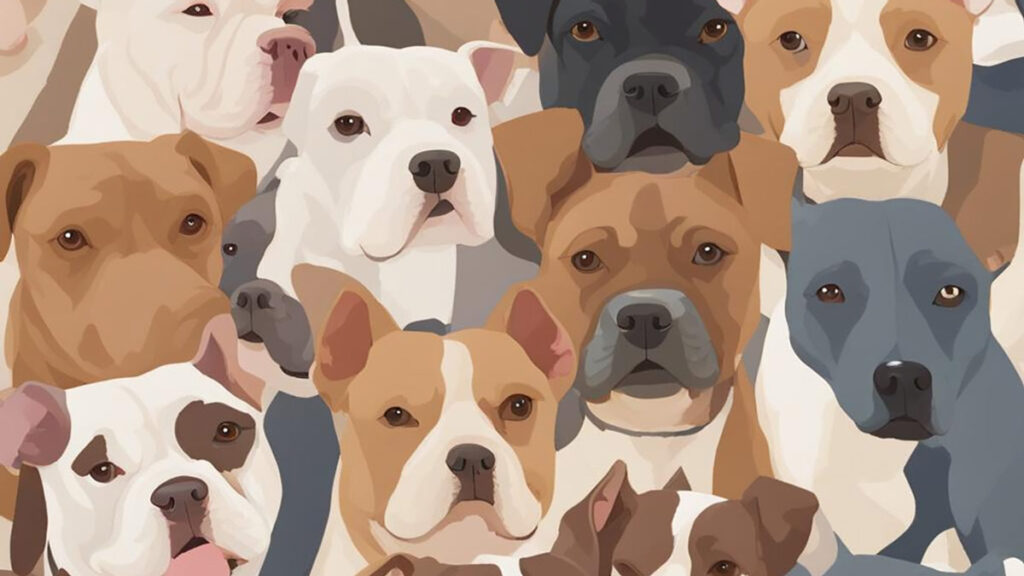Dogs that look like pit bulls – Explore the breeds of dogs similar to pitbulls

From parks to social media feeds, one cannot escape encountering dogs that share striking similarities with pit bulls. There are so many breeds that look like pit bulls. However, while these breeds may look alike, it is crucial to remember that appearances can be deceiving, and not all dogs with similar features are actually pit bulls. Understanding the subtle breed differences is vital to promote fairness and dispel unwarranted stereotypes.
As we delve into this topic, we’ll uncover the striking similarities that make these breeds resemble pit bulls while shedding light on the importance of understanding their unique differences. Whether you’re a seasoned dog enthusiast or a curious newcomer, this article will equip you with valuable insights to navigate the intriguing world of pit bull look-alikes. Some of the dogs similar to pitbulls are dangerous due to their character, but some are quiet and lovable.
What Things Make Dog Breeds Look Like a Pit Bull?
Pit bulls have long captivated the hearts of dog enthusiasts worldwide. Their distinctive appearance and loyal nature make them a beloved choice for many pet owners. However, it’s essential to recognize that not all dogs with a similar look are actual pit bulls. In this section, we’ll explore the defining characteristics commonly associated with pit bulls and the features that set them apart from other breeds.
Pit bulls are not a specific breed but rather a group of breeds that share similar physical traits and ancestry. The American Pit Bull Terrier, Staffordshire Bull Terrier, American Staffordshire Terrier, and sometimes the Bull Terrier are among the breeds frequently referred to as pit bulls.
One of the most recognizable features of pit bulls is their distinct head shape. They typically have broad, flat skulls and well-defined cheek muscles, giving them a strong and determined expression. Additionally, pit bulls often possess a pronounced, square-shaped muzzle, adding to their unique appearance.
Their robust and muscular build is another defining characteristic. Pit bulls boast a powerful and athletic physique, with a well-developed chest and sturdy limbs. This physical strength contributes to their reputation as excellent working and companion dogs.
Pit bulls come in various coat colors and patterns. The most common colors include brindle, fawn, black, blue, and red. Some pit bulls may have a combination of these colors or come in solid shades. Their coat is short, dense, and glossy, enhancing their charming allure.
It’s essential to recognize that several other breeds and mixed-breed dogs can bear resemblance to pit bulls. Dogs with broad heads, strong jawlines, and muscular builds may be mistaken for pit bulls, leading to misunderstandings and misidentifications.
To accurately determine a dog’s breed, a professional DNA test or consultation with a veterinarian or animal behaviorist is recommended. Understanding a dog’s breed heritage can provide valuable insights into its behavior, temperament, and potential health concerns.
Dogs that look like pit bulls – Dog Breeds That Share Similarities with Pit Bulls
What breed of dog looks like a Pit Bull?
Pit bulls have a distinctive appearance that can sometimes lead to confusion when identifying other breeds. Explore some of the dog breeds that are often mistaken for pit bulls due to their striking resemblances. Each of these breeds has its unique history, purpose, and charm, making them fascinating companions in their own right. Following are the famous breeds of dogs that look like pit bulls:
American Staffordshire Terrier – looks similar to pit bull
The American Staffordshire Terrier, often affectionately referred to as the AmStaff, shares a common ancestor with the pit bull. Developed in the United States in the 19th century, this breed was initially bred for bull-baiting and bear-baiting. Over time, the AmStaff’s tenacious spirit and loyalty made it a favorite family pet. It features a broad head, muscular build, and short coat, closely resembling its pit bull cousins.
Boxer
Originally from Germany, the Boxer is renowned for its playful and energetic nature. This breed’s history traces back to the 19th century, where it was bred for hunting and guarding purposes. Boxers have a square-shaped head, a powerful jaw, and a sleek, short coat, often leading to confusion with pit bulls. However, their friendly and gentle disposition sets them apart from their more assertive counterparts.
Bull Terrier
The Bull Terrier, with its egg-shaped head and triangular eyes, bears a striking resemblance to pit bulls. This breed’s roots go back to 19th-century England, where it was bred for dogfighting, which thankfully is no longer a part of its history. Bull Terriers are known for their fun-loving and mischievous personalities, making them popular companions among families and individuals alike.
Dogo Argentino
Originating from Argentina in the early 20th century, the Dogo Argentino was created for big-game hunting and as a loyal guardian. With its muscular build, strong jaw, and short white coat, the Dogo Argentino can be mistaken for a pit bull. However, this breed is known for its courage, intelligence, and unwavering loyalty to its human family.
Cane Corso
The Cane Corso hails from Italy, where it served as a working dog for farmers and hunters. Known for its imposing size and muscular frame, the Cane Corso may share physical traits with pit bulls. Its distinctive feature is a large, square head and a short, dense coat. Despite its formidable appearance, the Cane Corso is known for its gentle and devoted nature toward its family.
The Controversy Surrounding Pit Bull Look-Alikes
Pit bulls and their look-alike breeds have long been at the center of a heated debate in the canine world. While these dogs possess admirable traits, they are often marred by stigma and misconceptions. In this section, we will delve into the controversies that surround pit bull look-alikes, the consequences of breed misidentification, and the vital role of responsible ownership in fostering a harmonious relationship between humans and their four-legged companions.
Stigma and Misconceptions Associated with Pit Bulls and Pit Bull-Like Breeds:
Pit bulls, as well as dogs that resemble them, suffer from unfair and unjust stereotypes. They are often wrongly labeled as aggressive, dangerous, and prone to violence. These misconceptions can be traced back to media sensationalism and isolated incidents, which overshadow the true nature of these breeds. In reality, pit bulls and their look-alikes can be loving, loyal, and gentle companions when raised in a loving and nurturing environment.
Breed Misidentification and Unfair Judgments:
Breed misidentification is a common issue that contributes to the perpetuation of the stigma surrounding pit bulls. Many dogs with similar physical features are often labeled as pit bulls, leading to prejudiced judgments and unwarranted discrimination. In some regions, breed-specific legislation (BSL) unfairly targets pit bulls and pit bull mixes, subjecting them to restrictions and even bans based solely on appearance rather than individual behavior.
The Importance of Responsible Ownership Regardless of the Breed:
Regardless of a dog’s breed or appearance, responsible ownership plays a pivotal role in shaping their behavior and temperament. Responsible owners understand the significance of proper training, socialization, and providing a loving environment. They recognize that aggression and problematic behavior in dogs are primarily the result of poor ownership, neglect, or mistreatment.
Owning any dog, including pit bull look-alikes, comes with responsibilities. Ensuring regular exercise, mental stimulation, and veterinary care are essential to maintain a happy and well-balanced canine companion. Responsible ownership also involves understanding the needs and limitations of the breed, as well as adhering to local laws and regulations.
Unraveling Breed-Specific Legislation (BSL): Pit Bulls and Look-Alike Breeds in the Crosshairs
Breed-Specific Legislation (BSL) is a hotly debated topic that has a significant impact on pit bulls and breeds that resemble them. In this section, we will delve into the concept of BSL, its implications on these dogs, and the criticisms it faces. We’ll also explore alternative approaches, such as breed-neutral laws, that prioritize responsible ownership over blanket breed bans.
- What is Breed-Specific Legislation (BSL) and its impact on pit bulls and look-alike breeds?
Breed-Specific Legislation (BSL) refers to laws and regulations that target specific dog breeds or breed types based on their appearance rather than individual behavior. Pit bulls and breeds resembling them are often the primary targets of such legislation due to misconceptions about their temperament and perceived danger.
The impact of BSL on pit bulls and look-alike breeds can be devastating. Many regions impose restrictions, licensing requirements, or outright bans on these breeds, leading to difficulties in finding homes and increasing the number of dogs in shelters. Additionally, BSL can perpetuate negative stereotypes, making it challenging for these dogs to find acceptance in communities.
- Potential flaws and criticisms of BSL:
BSL has faced significant criticism from animal welfare experts, veterinarians, and advocacy groups. Some of the key flaws and criticisms include:
a) Ineffectiveness: Studies show that BSL does not necessarily reduce dog-related incidents. It fails to address the root cause of aggressive behavior, which is primarily influenced by individual factors such as training, socialization, and responsible ownership.
b) Inaccurate breed identification: BSL often relies on visual identification of breeds, which can be unreliable and prone to errors. Determining a dog’s breed based solely on appearance can lead to misidentifications and unjust consequences for innocent animals.
c) Impact on responsible owners: BSL unfairly penalizes responsible dog owners who may have well-behaved and loving pets of the targeted breeds. Such laws create unnecessary stress and financial burdens for responsible owners who are already committed to their dog’s welfare.
d) Diverting resources: BSL diverts resources away from more effective measures, such as educating owners on responsible pet ownership, promoting spaying/neutering, and enforcing laws targeting irresponsible owners and aggressive dogs, regardless of breed.
- Alternative approaches: Breed-neutral laws that focus on responsible ownership
A more effective and fair alternative to BSL is breed-neutral legislation that emphasizes responsible pet ownership. Rather than targeting specific breeds, these laws hold all dog owners accountable for their pets’ behavior. Key aspects of breed-neutral laws include:
a) Education: Implementing educational programs to raise awareness about dog behavior, training, and responsible ownership.
b) Licensing and registration: Requiring all dog owners to obtain licenses and register their pets, which can help authorities identify and track potentially dangerous dogs, regardless of breed.
c) Behavior assessments: Conducting behavior assessments for all dogs involved in incidents, rather than relying on breed-based assumptions.
d) Enforcement: Strictly enforcing laws related to leash control, proper containment, and aggressive behavior, regardless of breed.
Dogs that look like pit bulls
Some remarkable dog breeds may bear a resemblance to pit bulls, but they each possess unique qualities that set them apart. From the American Staffordshire Terrier’s unwavering loyalty to the Boxer’s playful exuberance and the Bull Terrier’s mischievous charm, each breed has a special place in the hearts of dog lovers. Understanding the historical context and original purpose behind these breeds enriches our appreciation for their distinctive traits and the roles they have played in human lives throughout history.
We must remember that appearances alone cannot definitively identify a dog’s breed. There are a lot of dogs that look like pit bulls in different regions. It is essential to appreciate the uniqueness of each dog and approach them with an open mind and heart, recognizing that their individual personality and behavior are what truly matter.
By focusing on education, responsible pet ownership, and evidence-based measures, we can foster a more inclusive environment that celebrates the diversity of all dog breeds.
As responsible pet owners, let us celebrate the diversity of these remarkable breeds and cherish the unique bond they form with us.

